There’s nothing quite like bringing home a bright-eyed, energetic ball of fur. You’ve imagined the perfect companion—loyal, confident, and eager to learn. But reality hits when your pup chews through shoes, ignores commands, or barks relentlessly. Sound familiar? You’re not alone. Many new German Shepherd owners struggle with similar frustrations, often because small missteps in early training snowball into bigger challenges.
This breed thrives on structure and leadership. Without it, their natural intelligence can turn into stubbornness. As Nadia Adams, a certified canine behaviorist, explains: “What you reinforce or overlook in the first six months shapes their adult behavior.” Skipping socialization, inconsistent routines, or using harsh corrections might seem harmless now, but these choices can lead to anxiety or reactivity later.
We’ve partnered with experts like Jacqui Foster, a breeder with 20 years of experience, to break down the five most common pitfalls. You’ll learn why delaying leash skills undermines trust, how missed socialization windows limit your dog’s confidence, and why “quick fixes” often backfire. More importantly, you’ll get actionable solutions to build a stronger bond with your pup.
Key Takeaways
- Early socialization prevents fear-based behaviors in adult dogs.
- Inconsistent commands confuse puppies and slow progress.
- Positive reinforcement builds trust faster than punishment.
- Leash training should begin before walks become problematic.
- Rushing milestones often leads to setbacks in obedience.
Understanding the Importance of Early Training and Consistency
Early experiences shape a puppy’s future more than most owners realize. Between 8 and 16 weeks, your dog’s brain is like a sponge, absorbing patterns that define their behavior for years. Miss this critical socialization window, and you risk creating an anxious adult who struggles with new environments or strangers.
Puppy’s Critical Socialization Period
Certified behaviorist Nadia Adams notes: “Positive exposure during these weeks builds confidence. Introduce varied sounds, surfaces, and people in short, upbeat sessions.” For example, pups exposed to gentle handling and urban noises early adapt better to vet visits or busy parks later.
Long-Term Impact on Behavior
Consistency matters just as much as timing. Using positive reinforcement, like treats for calm crate entries, creates trust faster than scolding mistakes. Research shows puppies trained with patience in this phase are 73% less likely to develop fear-based aggression.
Think of socialization as a vaccination against future stress. Pairing a crate with rewards teaches self-soothing, while structured playdates prevent overexcitement. Every calm interaction now strengthens your bond and their obedience down the road.
Common Training Mistakes New German Shepherd Owners Make
Training a highly intelligent breed comes with unique challenges that many don’t anticipate. While their sharp minds excel at learning, small communication errors can derail progress. Let’s explore three widespread missteps that create unnecessary friction between owners and their dogs.
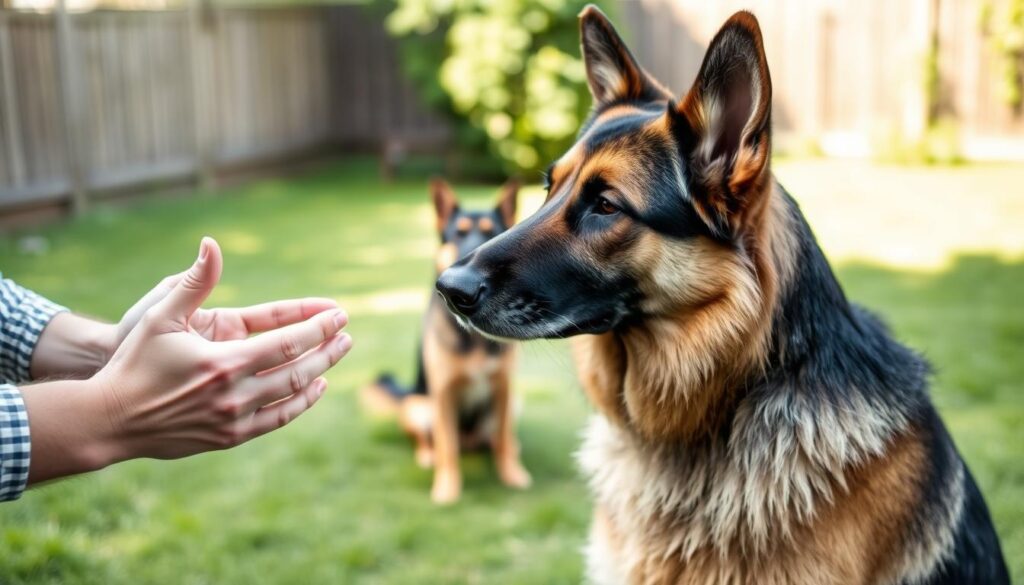
A Brief Overview of Key Pitfalls
Inconsistent command reinforcement tops the list. Saying “down” one day and “lie down” the next confuses this perceptive breed. Zigzag’s training team emphasizes: “Dogs thrive on predictability—changing phrases mid-session erodes trust in your leadership.”
Another critical error? Expecting puppies to decode human language. Telling a 12-week-old pup to “stop chewing the couch” overloads their cognitive capacity. OneMind Dogs’ research shows puppies respond best to single-action cues like “leave it,” paired with immediate redirection.
Consider Max, a 5-month-old Shepherd who barked relentlessly when guests arrived. His owners tried yelling “quiet” while handing treats—unintentionally rewarding the behavior. By switching to a calm “settle” command before barking started, they saw improvement in two weeks.
These examples highlight why aligning methods with the breed’s needs matters. Later sections will cover practical fixes, like using hand signals with verbal cues and structuring 5-minute training bursts. Small adjustments now prevent years of frustration.
Overlooking Socialization Fundamentals
The quiet moments matter just as much as the active ones when raising a confident companion. Socialization isn’t just about meeting dogs at the park—it’s creating positive associations with everyday sights, sounds, and interactions. Miss this foundation, and you risk lifelong behavioral challenges.
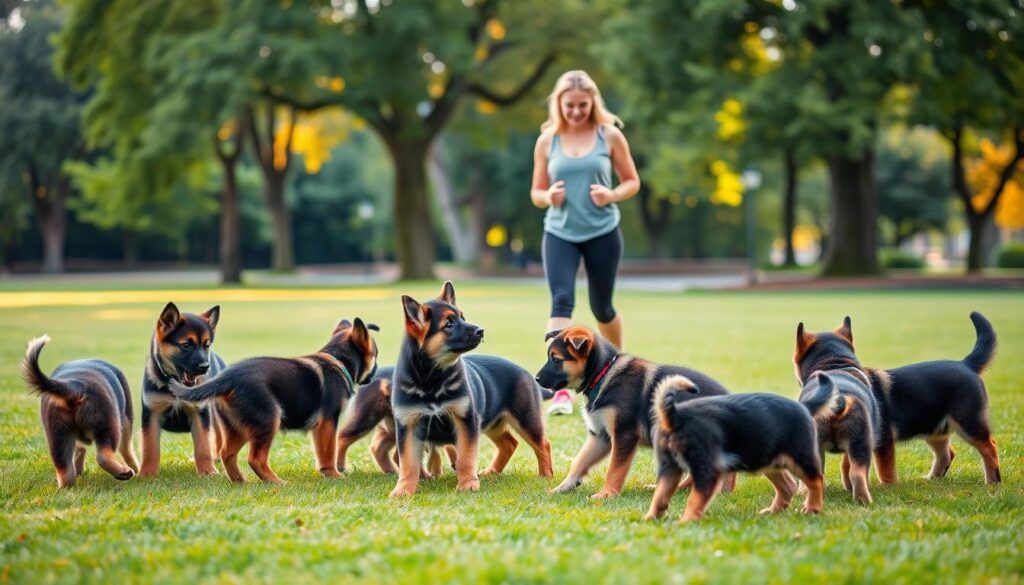
Harmful Effects of Delayed Socialization
An AKC Rescue Network spokesperson warns: “Dogs lacking early exposure often develop fear-based reactions. A shepherd who hasn’t heard traffic by 16 weeks might panic at garbage trucks later.” Data shows 68% of reactive dogs in shelters had limited socialization before six months.
Consider Luna, a 2-year-old shepherd adopted during lockdown. Her owners skipped neighborhood walks, assuming she’d “adapt later.” Now, she trembles at strangers and lunges at skateboards. Retraining requires a lot more effort than prevention.
Real-Life Examples of Socialization Gone Wrong
Structured interactions matter. Letting your pup meet 20 dogs in one day can overwhelm them. Zigzag app trainers recommend controlled playdates: “Pair calm adult dogs with puppies for 10-minute sessions. Reward calm behavior with treats.”
One owner learned this the hard way. Their dog barked incessantly at delivery workers after only seeing them through windows. By gradually introducing uniformed friends with high-value rewards, they reduced anxiety in three weeks.
Socialization isn’t optional—it’s preventive care. Puppy classes and exposure checklists build resilience. Your effort today shapes their confidence tomorrow.
Inconsistent Command Reinforcement
Mixed signals create chaos in a puppy’s world. Imagine being told “sit” one moment and “down” the next for the same action—your dog feels that confusion daily. This breeds hesitation, not trust.
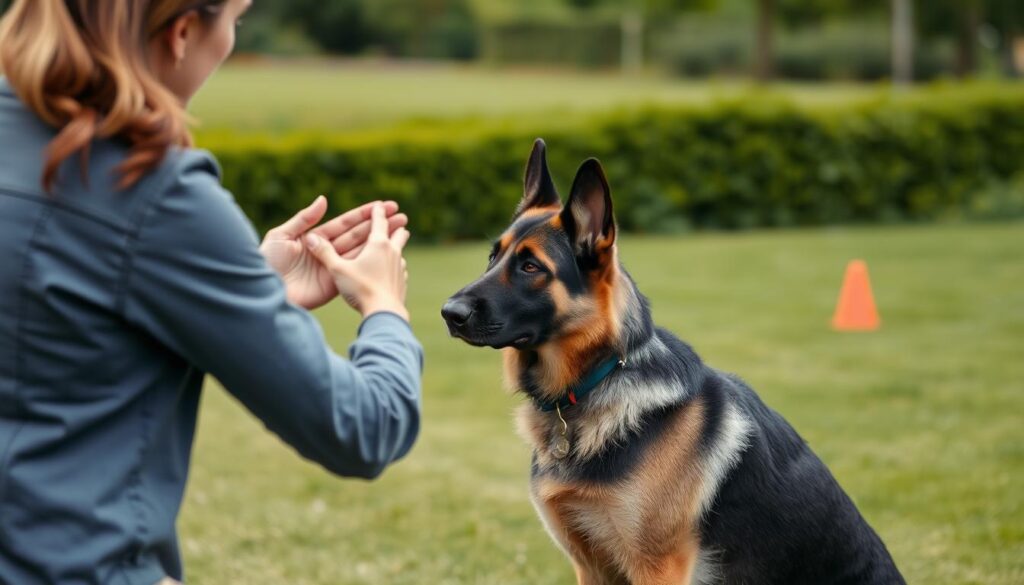
Why Predictability Builds Confidence
Professional trainer Laura Bennett explains: “Dogs learn through patterns. Changing phrases mid-training erases progress—like restarting a video game every 10 minutes.” Studies show puppies master commands 40% faster when owners use identical wording.
Inconsistent reinforcement also fuels unwanted behaviors. Letting your pup jump on guests “sometimes” teaches them to test boundaries. Structured repetition with treats for calm greetings works better.
Simple Strategies for Steady Results
Start with these expert-approved methods:
- Create a family command cheat sheet (e.g., “off” for no jumping)
- Pair verbal cues with hand signals—visual learners respond 2x faster
- Practice 5-minute sessions before meals when focus peaks
Involve all household members in training. Kids can reinforce “stay” during play using the same tone. Consistency across interactions prevents mixed messages that delay agility skill development.
Struggling with separation challenges? Use a specific phrase like “be back” when leaving. Over time, this builds emotional resilience. Remember—every clear command strengthens your leadership and their obedience.
Neglecting Crate and Housetraining Techniques
A well-structured routine is your secret weapon in raising a confident companion. Crate training isn’t just about confinement—it’s about creating a safe, predictable environment that reduces stress for both you and your dog. Separation anxiety often develops when puppies lack clear boundaries, but methodical practices prevent this.
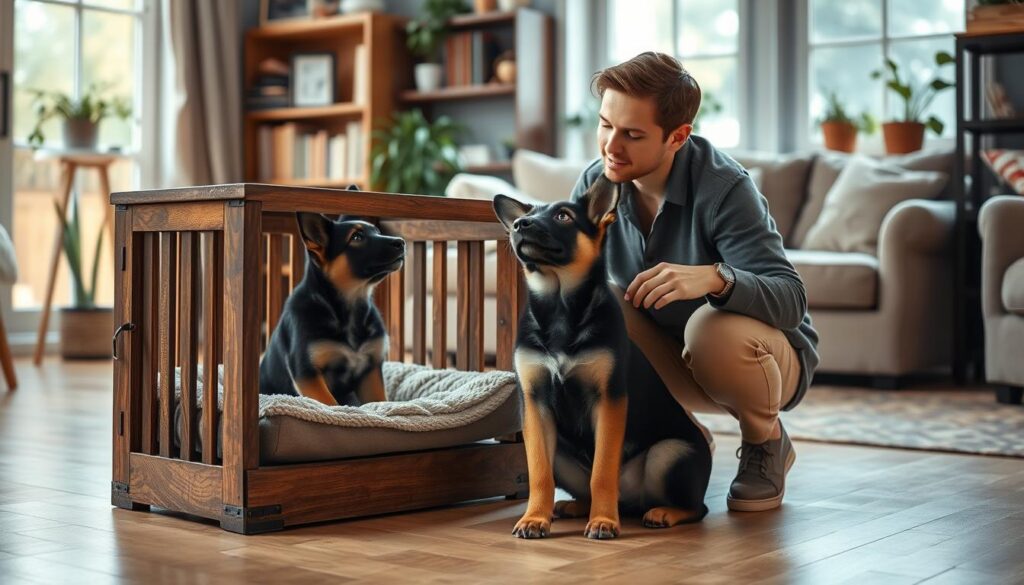
Benefits of Methodical Crate Training
Certified behaviorist Nadia Adams emphasizes: “Dogs view crates as dens when introduced positively. Start with 5-minute sessions while tossing treats inside- never force entry.” This approach helps puppies associate the space with comfort, not punishment.
Follow these steps for success:
- Place the crate in a quiet area of your home with cozy bedding
- Feed meals near the crate to build positive associations
- Gradually increase alone time after they settle calmly
Handling Accidents with Patience
Trainer Alexa Hagood notes: “Accidents are learning opportunities, not failures. Clean thoroughly with enzyme sprays to remove scent markers.” One owner reported 80% fewer indoor incidents after sticking to a strict potty schedule.
If your pup has an accident:
- Interrupt gently without scolding
- Take them outside immediately
- Reward successful bathroom breaks enthusiastically
Consistency in crate training and bathroom routines builds trust. Over time, your dog will seek their crate voluntarily—a win for separation anxiety prevention and household harmony.
Skipping Mental Stimulation and Play
Your dog’s body isn’t the only thing needing exercise—their mind craves challenges too. While walks burns energy, intelligence-building activities prevent boredom-driven destruction. Zigzag’s training team warns: “A mentally understimulated shepherd will create their own ‘work’—usually involving shredded cushions.”
Why Brain Games Matter as Much as Fetch
The OneMind Dogs method proves that cognitive exercises boost work ethic. Agility drills that combine physical jumps with directional commands (“left!” or “through!”) engage both body and mind. Studies show that dogs completing these tasks daily learn commands 30% faster.
Try these reinforcement-rich activities:
- Puzzle feeders that reward problem-solving with treats
- “Find it” games using hidden toys in your yard
- Obedience drills incorporating hand signals alongside verbal cues
Jacqui Foster, a K9 trainer, shares: “Shepherds thrive when given jobs. Teach ‘clean up’ by having them fetch toys into a basket—it channels their natural drive.” This approach builds intelligence while reinforcing your bond.
Rotate activities weekly to maintain engagement. A 15-minute scent-tracking session tires them mentally more than an hour-long walk. Pair physical exertion with work that requires focus, and you’ll see calmer behavior at home.
Remember—reinforcement isn’t just about treats. Praise, playtime, or a favorite chew toy all reward mental effort. Balance is key: A dog challenged both physically and cognitively becomes the well-rounded companion you envisioned.
Reacting Negatively to Misbehavior
Your immediate response to unwanted actions shapes your dog’s long-term behavior more than you might realize. Many owners instinctively scold or yell when their pup chews furniture or jumps on guests, not knowing this approach often backfires.
Why Negative Attention Can Reinforce Bad Habits
Dogs live in the moment. When you shout “No!” after finding shredded shoes, they connect your anger with the current situation, not their earlier action. Certified trainer Mia Torres explains: “Harsh reactions raise stress hormones. Over time, this creates anxious breeds that hide behaviors instead of learning better ones.”
Consider Baxter, a 6-month-old shepherd mix. His owner scolded him daily for counter-surfing, which only made him sneak food faster. When they switched to rewarding calm behavior with interactive toys during meal prep, the problem stopped in 11 days.
Embracing Patience and Positive Alternatives
Redirecting energy works better than punishment. Keep high-value toys handy to swap for forbidden items. If your dog digs, create a sandbox area and celebrate when they use it. Studies show that dogs taught through positive reinforcement obey commands 53% more consistently.
Key strategies for tough days:
- Use puzzle toys to channel chewing instincts constructively
- Practice “leave it” with treats instead of grabbing stolen items
- Reward calm behavior before anxiety escalates
Remember—every interaction teaches something. As Torres notes, “Dogs repeat what gets attention. Focus on what you want to see, not what frustrates you.” Consistent positivity builds trust that lasts through all life stages.
How to Train a German Shepherd Puppy
Great training starts long before teaching “sit” or “stay.” Your space and tools shape your dog’s ability to focus and learn. Zigzag’s canine experts stress: “A structured setup prevents 60% of common obedience struggles.” Let’s explore how to create a guide that sets you both up for wins.
Setting Up an Effective Training Environment
Choose a low-distraction zone—a corner of your living room or spare bedroom works. OneMind Dogs recommends these elements:
- Visual barriers: Use baby gates to block off high-traffic areas during sessions
- Non-slip matting for secure footing during commands
- Storage bins for quick access to treats and toys
Keep sessions under 10 minutes initially. Certified trainer Ryan Carter notes: “Dogs learn best in bursts. Three 5-minute drills spread through the day beat one marathon session.”
Choosing the Right Rewards and Tools
High-value treats like freeze-dried liver or cheese bits work wonders. Rotate rewards weekly to maintain excitement. For toy-driven dogs, keep a special tug rope reserved only for training.
Consider these breed-specific tools:
- Adjustable harnesses that don’t restrict shoulder movement
- Long-line leashes (15-30 ft) for outdoor recall practice
- Puzzle feeders that challenge their problem-solving skills
Jacqui Foster advises: “Match rewards to the difficulty level. Use kibble for basic commands, but break out the steak bites for complex tasks.” This guide to intentional environment design and reward selection creates a roadmap for stress-free learning.
Utilizing Quick Tips and Alternative Methods to Correct Errors
Adjusting your approach in the moment can transform frustrating training sessions into breakthroughs. Small shifts in timing or technique often yield faster results than overhauling entire routines. Certified trainer Carla Martinez notes: “The best corrections happen during the behavior, not after. This builds clear cause-and-effect understanding.”
Real-Life Examples for Clear Corrections
When 6-month-old Duke started lunging on walks, his owner tried pulling back on the leash. Trainer Tasha Reid intervened with a quick fix: “We redirected his focus by tossing treats behind us. Now he checks in voluntarily when distractions appear.” This way of responding preserved Duke’s confidence while teaching impulse control.
Another common issue? Barking at doorbells. Instead of shouting “quiet,” trainer-approved methods work better. One family used the “find it” game—tossing kibble away from the door—to create positive associations. Immediate rewards for calm behavior reduced reactions by 90% in three weeks.
Key strategies for real-time adjustments:
- Use high-value treats to interrupt unwanted actions mid-sequence
- Pair verbal praise with physical rewards for layered reinforcement
- Practice “errorless learning” by setting up scenarios where success is likely
These methods prove that corrections don’t require harshness. As Martinez explains: “Every interaction is a teaching moment. Celebrate the tries, not just perfection.” Integrating these tweaks into daily life creates consistent progress and a happier partnership.
Incorporating Visuals and Infographics in Training Sessions
Visual tools do more than catch your eye—they create lasting understanding for your dog. Busy owners often struggle to explain complex techniques verbally, and charts, videos, and illustrated guides bridge the gap between intention and execution.
How Visual Aids Enhance Learning
Zigzag’s research shows dogs process visual cues 30% faster than verbal ones alone. OneMind Dogs’ trainers emphasize: “Pairing hand signals with commands like ‘sit’ or ‘stay’ helps puppies grasp concepts in fewer sessions.” For example, a simple infographic breaking down leash training steps can prevent confusion during hectic times.
Infographics transform multi-step processes into digestible visuals. Imagine teaching “Leave It” using a photo series showing gradual treatment distancing. Owners report 50% faster obedience when using these tools alongside verbal cues.
Consistency thrives with visual reminders. Post a chart of daily training goals on your fridge—it keeps everyone accountable. Rotate materials monthly to match your dog’s growing skills. Structured sessions using these aids prevent skipped steps, even when life gets busy.
Integrate visuals naturally: Watch tutorial videos together before practice, or use flashcards during play. As one owner shared: “The ‘fetch’ diagram helped us fix retrieval issues in three days—way faster than yelling ever did!” Your effort to blend methods pays off in calmer, more effective obedience training.
German Shepherd puppies need different training
Conclusion
Raising a confident companion requires teamwork between you and your dog. The learning period during their first six months sets the foundation for years of trust and cooperation. By addressing common missteps—delayed socialization, inconsistent commands, and reactive corrections—you build resilience against future stress.
Keep this checklist handy:
1. Start exposure to new sights/sounds early and often
2. Use identical verbal cues across all family members
3. Reward calm behavior before challenges escalate
4. Pair physical exercise with mental puzzles daily
5. Document progress with video journals or charts
Structured routines with visual aids help puppies thrive. Involve your whole family in training sessions to maintain consistency. Remember—every positive interaction during this critical period strengthens your bond and their confidence.
You’ve got this. With patience and the right tools, you’ll nurture a loyal partner ready to face life’s adventures beside you. Now’s the time to put these strategies into action and watch your efforts blossom.
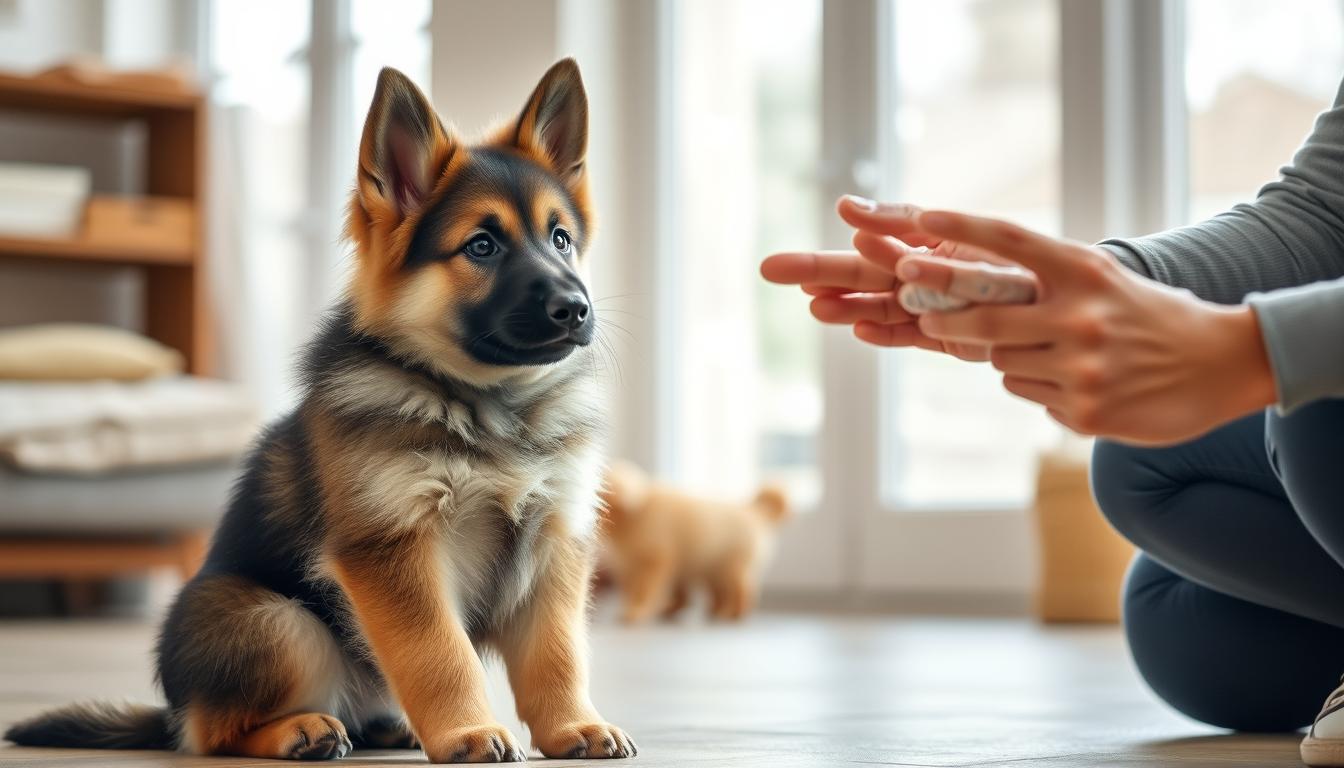
It’s remarkable to pay a visit this website and reading the views
of all mates about this article, while I am also zealous of getting experience.